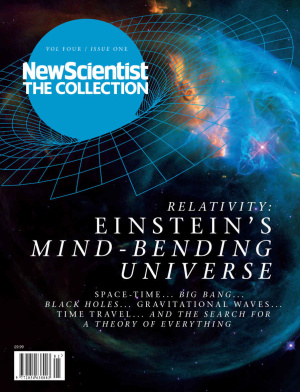Reed Business Information Ltd. — 423 p. — ASIN: B06XJ2QH5N
Международный научный журнал, охватывающим последние события в
области науки и техники. Наряду с обзором текущих событий и
новостей, в журнале часто представлены и исследовательские статьи,
начиная от технических до философских.
In a few short years in the early 20th century, an iconoclastic young physicist single-handedly transformed our understanding of the universe. With his special and general theories of relativity, Albert Einstein overtued the solid certainties of Newton’s clockwork universe and replaced it with one that defies common sense understanding. His work brought us the famous equation E=mc2, revealed light as the fastest thing in the universe, and introduced the bizarre concept of time dilation. It unified space and time, redefined gravity, and ushered in the idea that the universe began in hot, dense fireball we now call the big bang. These ideas later gave rise some of the most intriguing and mind-boggling ideas in mode physics: black holes, dark matter and energy, and time travel. Today’s physicists are still wrestling with his ideas and their consequences, including how to build them into the ultimate theory of everything.
It is hard to overstate Einstein’s influence on mode science, and yet his theories remain arcane and sometimes misunderstood. This issue of New Scientist: The Collection introduces the man and his astonishing ideas - and explains how they will lead to the next great revolution in our understanding of the cosmos.
From of Contents
The cosmos reimagined
The relativistic universe
Holes in space-time
Ripples in the fabric
Was Einstein wrong?
Beyond relativity
In a few short years in the early 20th century, an iconoclastic young physicist single-handedly transformed our understanding of the universe. With his special and general theories of relativity, Albert Einstein overtued the solid certainties of Newton’s clockwork universe and replaced it with one that defies common sense understanding. His work brought us the famous equation E=mc2, revealed light as the fastest thing in the universe, and introduced the bizarre concept of time dilation. It unified space and time, redefined gravity, and ushered in the idea that the universe began in hot, dense fireball we now call the big bang. These ideas later gave rise some of the most intriguing and mind-boggling ideas in mode physics: black holes, dark matter and energy, and time travel. Today’s physicists are still wrestling with his ideas and their consequences, including how to build them into the ultimate theory of everything.
It is hard to overstate Einstein’s influence on mode science, and yet his theories remain arcane and sometimes misunderstood. This issue of New Scientist: The Collection introduces the man and his astonishing ideas - and explains how they will lead to the next great revolution in our understanding of the cosmos.
From of Contents
The cosmos reimagined
The relativistic universe
Holes in space-time
Ripples in the fabric
Was Einstein wrong?
Beyond relativity

